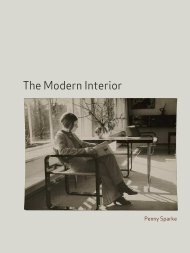Landscape Architecture: Landscape Architecture: - School of ...
Landscape Architecture: Landscape Architecture: - School of ...
Landscape Architecture: Landscape Architecture: - School of ...
- No tags were found...
You also want an ePaper? Increase the reach of your titles
YUMPU automatically turns print PDFs into web optimized ePapers that Google loves.
Early design sketch <strong>of</strong> the lake looking north, showing wetlands and<br />
allotments on the left side <strong>of</strong> the lake, new ‘urban forests’ as long strips<br />
perpendicular to the lake edge, the new straight lake edge on the right side<br />
<strong>of</strong> the lake, and the new town edge to the lake with ramping harbour.<br />
The Cospuden mining excavation process has uncovered 50 million years <strong>of</strong><br />
geological history. This aerial photograph shows how the process has turned<br />
the area into an apocalyptic morass <strong>of</strong> waste and water.<br />
mass was then to be fragmented by alleyways for easy<br />
pedestrian access. Thus an infrastructural framework was<br />
created overall to play host to human settlements, themselves<br />
unconstrained by urgent time-framing.<br />
ARU’s architecture here includes completed buildings <strong>of</strong><br />
an exemplary quality. Beigel’s ethos has been to conceive<br />
buildings <strong>of</strong> a clear, tectonic, but simple pr<strong>of</strong>ile, which<br />
respect the existing and reclaimed landscape. As<br />
demonstrated by their Stone units, and already realised<br />
<strong>of</strong>fices for the Youl Hwa Dang Publishing House, which act<br />
as a bridge across the wetlands, this allows definitive aspects<br />
<strong>of</strong> the architecture to relate naturally to the site terrain and<br />
ecology, as well as to distant views.<br />
One <strong>of</strong> ARU’s major breakthroughs at Paju Book City has<br />
been a recognition <strong>of</strong> the high ecological value <strong>of</strong> the residual<br />
wetlands that characterise the original site. These were,<br />
according to an outmoded plan, to be filled in and gravelled<br />
over. However, Beigel’s defining decision was to reverse this<br />
implementation, and so to save the natural ecology <strong>of</strong> reeds<br />
and grasses that could now take the form <strong>of</strong> the ‘picnic’ on<br />
the rug. According to ARU: ‘It is necessary to tread carefully in<br />
this delicate land, in a way a giraffe would walk through high<br />
grass.’ Essentially, the architects therefore prepared a plan <strong>of</strong><br />
‘where not to fill the land’. This aspect <strong>of</strong> the overall plan<br />
remains but, as Beigel says, is always at risk <strong>of</strong> despoliation by<br />
commercial or governmental bodies, though some progress in<br />
enlightening such bodies has been made.<br />
By autumn 2000, when architects were starting to be<br />
commissioned to realise individual buildings according to the<br />
Paju Design Guide, Mr Yi Ki Ung, President <strong>of</strong> the Youl Hwa<br />
Dang Publishing House, commissioned Florian Beigel and<br />
ARU, London, in collaboration with Kim Jong Kyu and MARU,<br />
Seoul, to design his own building. This building was to act as a<br />
prototype, a built demonstration <strong>of</strong> the urban concepts in the<br />
Paju Design Guide. The building is best described as a cluster<br />
<strong>of</strong> studio houses around courtyards, or ‘madangs’. The principle<br />
<strong>of</strong> ‘a house <strong>of</strong> good rooms’ (in Beigel’s words) was followed,<br />
whereby one goes from room to room. This is not a house with<br />
an open plan, or <strong>of</strong> corridors and separate rooms, it is a house<br />
<strong>of</strong> rooms without corridors. But this clarity also reflects the<br />
way the city is laid out, allowing for an unusual degree <strong>of</strong><br />
coherence through each and every scale <strong>of</strong> living and moving.<br />
The colours <strong>of</strong> the studio houses, their walls and bookshelves<br />
are painted consistently in a palette similar to that developed<br />
by the Italian painter Giorgio Morandi – s<strong>of</strong>t and subtle, with<br />
equal emphasis placed on the spaces between elements<br />
(houses, rooms, shelves) as on the solid or transparent<br />
volumes. One <strong>of</strong> the walls <strong>of</strong> every room in the studio houses<br />
is a wall <strong>of</strong> light, created using light-diffusing materials.<br />
Turning again to the landscape form, Beigel found that the<br />
site reflects a strong north–south linearity, as read from the<br />
Han River’s long, but wide, impact on the land itself. This is<br />
emphasised by the Simhak Mountain in Paju, which seems to<br />
guard the city. It was this linearity that generated the whole<br />
concept <strong>of</strong> the book city, as a kind <strong>of</strong> built landscape text. It is<br />
also hoped that the Freedom Highway, which connects Paju<br />
City to the centre <strong>of</strong> Seoul, will one day become the direct<br />
connection to North Korea. The land and flood plain <strong>of</strong> the<br />
Han River was the site <strong>of</strong> extremely bloody battles during the<br />
Korean War, thus the highway has more than just a<br />
topographical significance.<br />
Paju Book City, in Beigel’s words, is conceived as a territory<br />
<strong>of</strong> coexistence: ‘We called it urban wetland. In more general<br />
terms we call it a “citylandscape”. Paju Book City will be<br />
neither a city nor will it be a built-up landscape. It will be<br />
both. In this way it will be a classical example for the<br />
contemporary urban condition. It is not a landscape design<br />
project, and it is not an urban design project. It is an<br />
93



